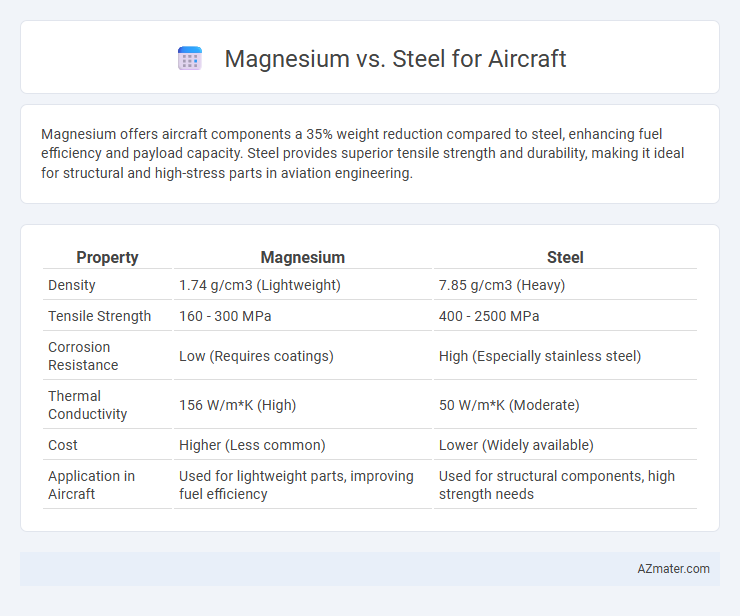Magnesium offers aircraft components a 35% weight reduction compared to steel, enhancing fuel efficiency and payload capacity. Steel provides superior tensile strength and durability, making it ideal for structural and high-stress parts in aviation engineering.
Table of Comparison
| Property | Magnesium | Steel |
|---|---|---|
| Density | 1.74 g/cm3 (Lightweight) | 7.85 g/cm3 (Heavy) |
| Tensile Strength | 160 - 300 MPa | 400 - 2500 MPa |
| Corrosion Resistance | Low (Requires coatings) | High (Especially stainless steel) |
| Thermal Conductivity | 156 W/m*K (High) | 50 W/m*K (Moderate) |
| Cost | Higher (Less common) | Lower (Widely available) |
| Application in Aircraft | Used for lightweight parts, improving fuel efficiency | Used for structural components, high strength needs |
Introduction: Magnesium vs Steel in Aerospace Engineering
Magnesium alloys offer exceptional strength-to-weight ratios, making them highly valuable in aerospace engineering where lightweight materials enhance fuel efficiency and performance. Steel provides superior tensile strength and durability, critical for structural components subjected to high stress and impact during flight. The choice between magnesium and steel in aircraft design depends on balancing weight reduction with mechanical reliability and corrosion resistance.
Material Properties: Comparing Magnesium and Steel
Magnesium offers a low density of approximately 1.74 g/cm3, significantly reducing aircraft weight compared to steel's density of about 7.85 g/cm3, which enhances fuel efficiency and payload capacity. Steel provides superior tensile strength, ranging from 400 to 2,000 MPa depending on the alloy, offering excellent durability and resistance to fatigue under high-stress conditions in aircraft structures. Magnesium's lower melting point (650degC) versus steel's higher melting point (1,370-1,540degC) affects thermal stability and manufacturing processes, making steel more suitable for high-temperature applications.
Strength-to-Weight Ratio Analysis
Magnesium exhibits a superior strength-to-weight ratio compared to steel, making it highly advantageous for aircraft components where weight reduction is critical. Magnesium alloys typically offer strengths around 200-350 MPa while weighing approximately one-third that of steel, which ranges from 400-600 MPa. This ratio allows aerospace engineers to optimize structural integrity without significantly increasing aircraft mass, improving fuel efficiency and overall performance.
Corrosion Resistance and Durability
Magnesium alloys offer lightweight advantages in aircraft construction but exhibit lower corrosion resistance compared to steel, often requiring protective coatings to prevent oxidation and degradation. Steel provides superior durability and inherent corrosion resistance, making it ideal for structural components exposed to harsh environments or stresses. The trade-off between magnesium's weight savings and steel's strength and corrosion resistance dictates their specific applications in aerospace engineering.
Manufacturability and Processing Techniques
Magnesium offers advantages in manufacturability for aircraft due to its low density and excellent castability, enabling complex shapes with precision through die casting and extrusion processes. Steel, while heavier, benefits from well-established manufacturing techniques such as forging, machining, and welding, providing superior strength and durability for critical components. Processing magnesium requires strict control of ignition risk during machining and handling, whereas steel's higher melting point allows for more flexible thermal treatments and joining methods in aerospace applications.
Cost Considerations and Availability
Magnesium offers significant cost advantages over steel in aircraft manufacturing due to its lower density, which reduces fuel consumption and operational expenses. While steel provides superior strength and durability, its higher weight contributes to increased production and maintenance costs. Magnesium is more abundant and easier to source globally, making it a cost-effective alternative, although corrosion resistance and supply chain stability must be carefully managed.
Applications in Modern Aircraft Design
Magnesium alloys, prized for their exceptional strength-to-weight ratio, are utilized in modern aircraft for non-structural components such as interior panels, seat frames, and instrument housings, significantly reducing overall aircraft weight and improving fuel efficiency. Steel, renowned for its high tensile strength and durability, is primarily employed in critical structural parts, landing gear, and engine components where load-bearing capacity and resistance to fatigue are essential. The complementary use of magnesium and steel in aircraft design enhances performance by balancing lightweight material advantages with structural integrity requirements.
Safety and Fire Risk Evaluation
Magnesium alloys, while lightweight and beneficial for fuel efficiency, present higher fire risks due to their flammability and difficulty to extinguish once ignited, demanding stringent safety measures in aircraft design. Steel, in contrast, offers superior fire resistance and structural integrity under high temperatures, reducing the likelihood of catastrophic failures during thermal events. Evaluating fire risk in aircraft materials prioritizes the balance between weight savings offered by magnesium and the enhanced fire safety profile of steel to ensure optimal passenger and structural safety.
Environmental Impact and Sustainability
Magnesium offers significant environmental benefits over steel in aircraft manufacturing due to its lower density, which reduces fuel consumption and carbon emissions during operation. The production of magnesium requires less energy compared to steel, resulting in a smaller carbon footprint and reduced greenhouse gas emissions. Recycling magnesium is also more energy-efficient, enhancing its sustainability profile in the aerospace industry.
Future Trends in Aircraft Material Selection
Magnesium alloys, known for their lightweight and high strength-to-weight ratio, are increasingly explored as alternatives to traditional steel in aircraft manufacturing to improve fuel efficiency and reduce emissions. Advances in corrosion resistance and fatigue durability of magnesium promise enhanced performance and longer service life, making it a competitive material in future aerospace designs. Ongoing research in composite integration and hybrid material structures suggests a shift towards multi-material frameworks that optimize both strength and weight properties in next-generation aircraft.

Infographic: Magnesium vs Steel for Aircraft
 azmater.com
azmater.com